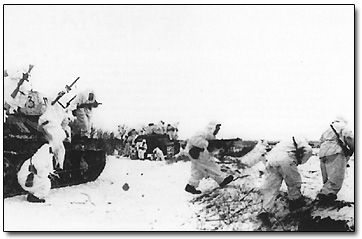World War II - Eastern Front - Brief Facts
Moscow, Leningrad and Rostov: Autumn 1941
Hitler then decided to resume the advance to Moscow, renaming the Panzer Groups to Panzer Armies for the occasion. Operation Typhoon, which was set in motion on 30 September, saw 2nd Panzer Army rush along the paved road from Orel (captured 5 October) to the Oka river. Army Group North positioned itself in front of Leningrad and attempted to cut the rail link at Tikhvin to the east. Thus began the 900-day Siege of Leningrad.
Victims of German Bombardment on Leningrad Street
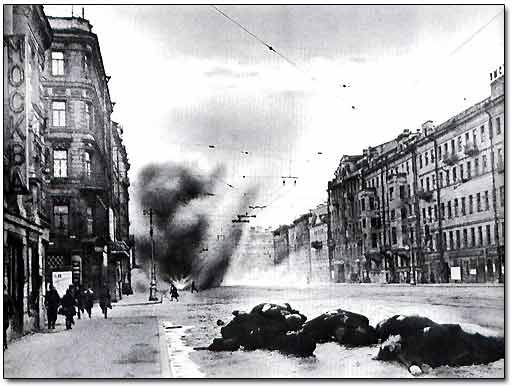
In the city with population of almost 3 million civilians (including about 400,000 children), there was no heating, no water supply, almost no electricity and very little food by the winter of 1941-42. From September 8 1941 to January 27 1944, one million Leningraders were evacuated. Roughly 800,000 had died of cold and starvation, and as many as another 200,000 were killed by bombing or in defending the city. Despite these tragic losses and the inhuman conditions, the city's war industries did not stop working and the city did not surrender.
Hauling the Dead to the Mass Grave for Burial (Leningrad, 1942)
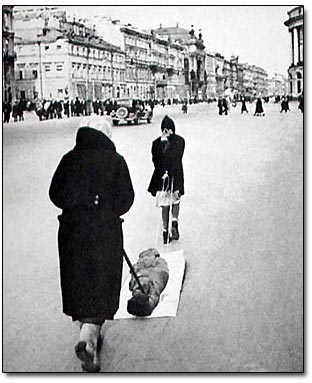
WW2 Russian Poster - "Defend the City of Lenin!"
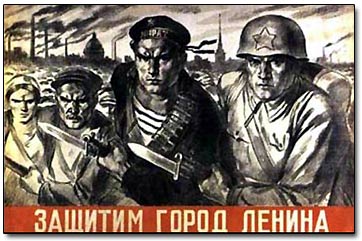
Army Group South pushed down from the Dnieper to the Sea of Azov coast, also advancing through Kharkov, Kursk and Stalino. The 11th Army moved into the Crimea and had taken control of all of the peninsula by autumn (except Sevastopol, which held out until 3 July 1942). On 21 November the Germans took Rostov, the gateway to the Caucasus. However, the German lines were overextended and the Soviet defenders counterattacked the 1st Panzer Army's spearhead from the north, forcing them to pull out of the city and behind the Mius River; the first significant German withdrawal of the war.
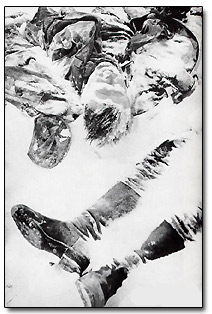
German Soldiers
Frozen to Death
Just as Operation Typhoon got going, the Russian weather struck. For the second half of October it rained solidly, turning what few roads there were into endless mud that trapped German vehicles, horses and men alike.
With 160 km (100 miles) still to go to Moscow, there was worse to come when the temperature plunged and snow started falling. The freezing temperatures grounded Luftwaffe aircrafts and oil froze in the sumps of the Panzer divisions' tanks. German soldiers could not move either freezing with no winter clothing.
The German leadership, expecting the campaign to be over in a few months, had not equipped their armies for winter fighting, and the Germans were in their summer uniforms and lacked winter camouflage. In addition to that, the gauge difference in railroad tracks between German and Soviet railroads delayed uniform and overall supply.
Germans attempted to throw a ring around Moscow on November 15th. On 27 November the 4th Panzer Army got within 30 km (19 miles) of the Kremlin when it reached the Moscow line at Khimki. Meanwhile the 2nd Panzer Army could not take Tula, the last Soviet city that stood in its way of the capital.
German Panzer Division Near Moscow
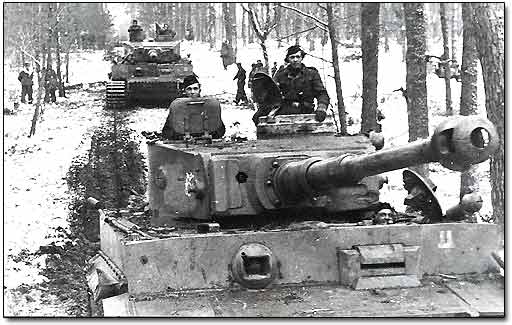
By December 6th, it became clear that the Wehrmacht was too weak to capture Moscow and the attack was put on hold. General Zhukov thus began his counterattack, employing fresh, well-trained Siberian reserves transferred from the east following the guarantee of neutrality from Japan.
Fresh Russian Troops Arriving from Siberia
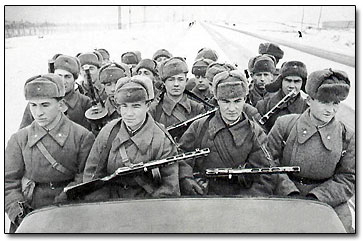
Soviet Counteroffensive: Winter 1941
During the autumn, Soviet marshall Zhukov had been transferring fresh and well-equipped Soviet forces from Siberia and the far east to Moscow. On 5 December 1941, these reinforcements attacked the German lines around Moscow, supported by new T-34 tanks and Katyusha rocket launchers.
"Katyusha" Rocket Launchers in Action
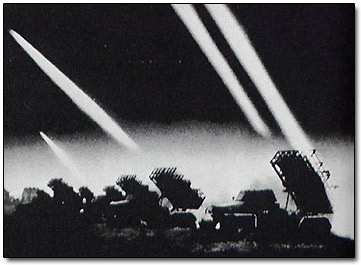
The new Soviet troops were prepared for winter warfare, and they included several ski battalions. The exhausted and freezing Germans were routed and driven back between 100 and 250 km (60 to 150 miles) by 7 January 1942.
Russian Motorized Infantry in Winter Camouflage
